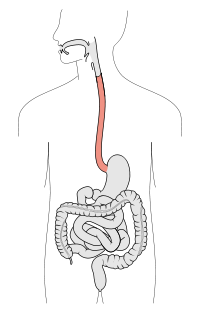
Photo from wikipedia
ObjectivesSwallowing and voice dysfunctions are common side effects following head-and-neck squamous-cell carcinoma (HNSCC) treatment. Our aim was to analyze the relationships between quality of life, swallowing, and phonatory problems in… Click to show full abstract
ObjectivesSwallowing and voice dysfunctions are common side effects following head-and-neck squamous-cell carcinoma (HNSCC) treatment. Our aim was to analyze the relationships between quality of life, swallowing, and phonatory problems in patients with an advanced-stage HNSCC and to prospectively evaluate the effects of a prophylactic swallowing program.MethodsFirst, we retrospectively studied 60 advanced HNSCC patients treated with exclusive or adjuvant radiotherapy/chemoradiotherapy (RT/CRT). Subjects were classified according to general and clinical–therapeutic features. Outcome measures included EORTC QLQ-C30, EORTC QLQ-H&N35, Dysphagia Handicap Index (DHI), M.D.Anderson Dysphagia Inventory (MDADI), and Voice Handicap Index (VHI). Then, we conducted a prospective evaluation of a prophylactic swallowing counselling in 12 consecutive advanced-stage HNSCC patients by a two-arm case–control analysis. These patients were treated with exclusive or adjuvant RT/CRT.Results71% of the retrospective population studied reported swallowing dysfunction as a major side effect. No differences were detected in the severity of dysphagia or dysphonia according to type of treatment or staging of the primary tumour, while hypopharyngeal and laryngeal cancer patients showed significantly better swallowing ability and better QoL compared to oral cavity and oropharyngeal localisation (p < 0.05). In addition, a relevant correlation between swallowing and voice problems emerged (p < 0.05). In the prospective part, while no statistical correlation was evident before the start of RT/CRT in the experimental group compared to the control one, the former showed better performances at MDADI (p = 0.006) and DHI (p = 0.002) test 3 months after its end.ConclusionDysphagia is both an acute-and-long-term side effect which greatly affects QoL of HNSCC patients undergoing multimodality treatment. Our data show that a prophylactic swallowing program could actually produce a beneficial effect on patients’ outcomes.Level of evidence1b and 2b.
Journal Title: European Archives of Oto-Rhino-Laryngology
Year Published: 2018
Link to full text (if available)
Share on Social Media: Sign Up to like & get
recommendations!